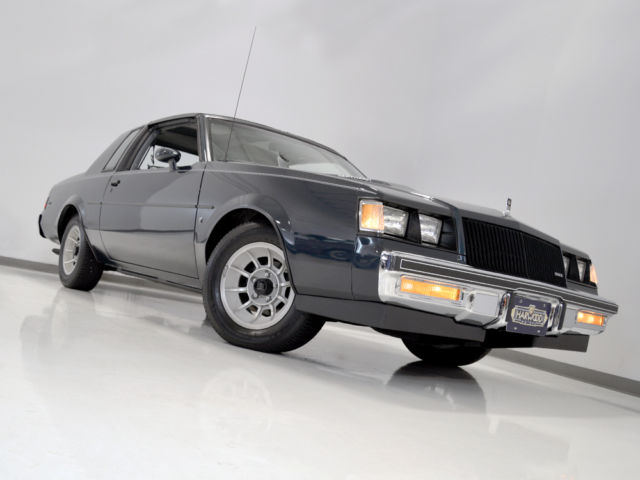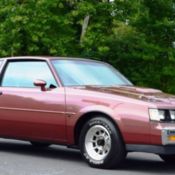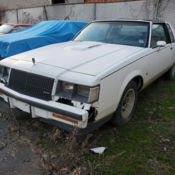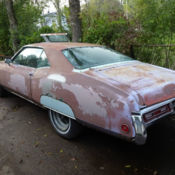Rare Limited Turbo-T, unmodified, leather buckets, console, ultra-clean car!
1987 Buick Regal Limited Coupe 2-Door
Quick! Name the fastest American production car of the 1980s. Corvette? Mustang 5.0? Camaro Z/28? You'd be wrong on all counts, and since you're reading this, you already know the answer is Buick's awesome turbocharged Regal. Almost everyone knows that the Grand National—and its more expensive limited-edition brother, the GNX—were the nastiest cars you could buy in 1987, packing a turbocharged and intercooled 3.8 liter V6 that grunted out a grossly under-rated 245 horsepower and 355 pounds of torque. But while the big, bad, black Buicks were ubiquitous on the drag strips and mean streets of late-80s America, if you really wanted a fast car and didn't like the "Hey, look at me!" blackout look, then the Turbo-T was exactly what you needed. Only 1035 Turbo-T Limited Regals like this one were built in 1987, making them considerably rarer than a garden-variety GN, and even rarer than the WE4 cars (of which 1547 were built). And since they used several different critical components, the Turbo-Ts were lighter and faster than the Grand National, too. Was this the ultimate predator? Hard to argue against it, even today.
Buick didn't work very hard to promote the availability of the turbocharged engine outside of the Grand National, but a few savvy buyers stepped up and ordered full-lux Regals and then checked the LC2 option box that included all of the GN's go-fast tricks, most notably the turbocharged engine. This beautifully restored 1987 Buick Regal Turbo-T has a clean look that comes complements of the WO2 exterior sport package, which blacked out most of the chrome save for the bumpers, ostensibly because Buick management didn't want to have two different all-black Buick turbos competing for space on the showroom floor. Whatever the reason, this car still carries a lot of presence, and the chrome bumpers don't knock the sharp edges off one bit. The paint was refinished in Sapphire Blue Metallic, a color that suits its elegant position in the GM hierarchy but doesn't downplay the car's impressive performance. The sheetmetal was all smoothed, sanded, and returned to factory spec and while it shows a few very minor signs of use, it really sparkles in the flesh. You'll note that the car does not have a padded roof, which often accompanied the base Regals, but it does have T-tops, which totally transform the Regal's personality. Other interesting contrasts include the stand-up chrome hood ornament and the power dome in the hood, plus a few subtle "T" and “Limited” emblems. Of course, the moldings and rubber pieces are all new, and those chrome bumpers look as good today as they did 30 years ago. In a sea of ordinary black Grand Nationals, this car really stands out, but does it without shouting very loudly. That's not an easy feat.
Whereas the Grand National came with cloth-covered bucket seats, you could get your Turbo-T with any of the other Regal chairs, including the gray leather buckets found in this one which are an extremely rare option. A big upgrade in my opinion, they've got that pillow-tufted look of a luxury car, but they're still separated by a functional center console (note the shifter is still on the column, another cool contrast). The leather is original, which will tell you just how nice this car really is, because aside from some light wear on the driver's seat, they're in excellent condition, with the back seat looking almost completely unused. The carpets were replaced during the comprehensive restoration, and they're now protected by a set of steely blue floor mats with the 'T' logo. The same steering wheel found on the Grand National, a leather-wrapped 3-spoke unit, was wrapped in two-tone leather for a more unique look, but only the experts will know it's not how the factory did it. The instruments are the same as the GN as well, including a tachometer and boost gauge, both LED strips that seem to have been haphazardly shoehorned into the cluster at the last moment (they both work, although the tach seems to read about 3500 RPM high, which is apparently common). This car is loaded with options, including A/C, power windows and locks, a tilt steering column, cruise control, and an AM/FM/cassette stereo system that still sounds decent in the hushed Buick interior. The door panels, dash pad, and weather seals are all in excellent condition, and the T-tops fit without leaking and store in their original bag. The trunk is also correctly outfitted with a space-saver spare and jack assembly.
The RPO LC2 3.8 liter turbocharged and intercooled V6 under the hood really needs no introduction. If you were there when these cars were new, you already know that when you see one of these on the road, you don't mess with it. In stock form, they're surprisingly fast, running away from much more potent-looking cars, but they're also very docile. You can drive this car around town and never know that there's a turbocharged powerplant at work; it's smooth, torquey, quiet, and never gets fussy. However, add in a few inexpensive modifications (please note that this car is 100% stock) and horsepower jumps by triple digits, turning these cars into weapons without any external evidence. That's the wonder of turbocharging. This car's engine was rebuilt to stock specs, including the turbo on top, so it runs and drives pretty much like it did back in 1987. Turn the key and the fuel injection fires it easy and it idles well, even when cold. As a turbocharged car running a speed-density engine management system, it runs best once it's warmed up and you'll find almost limitless torque available at any engine speed. It loafs along at highway speeds, and a gentle squeeze on the throttle is rewarded with a surprising change of pace. The boost gauge lights up and suddenly the car is lunging forward as if it's on the end of a giant recoiling rubber band. The feeling is uncanny and probably why these cars remain enduringly popular year after year.
A 200-4R 4-speed automatic overdrive transmission was your only choice, and the past 30 years have taught us that it's plenty durable behind the turbo motor. The turbo builds power evenly, so it never hammers the transmission, and thanks to the comprehensive freshening, this one shifts cleanly and operates just as it should so you should be able to enjoy it for many years to come. Selecting the turbo motor also got you a very stout rear end with GU6 3.42 gears on a G80 Positraction limited slip with semi-floating rear axles—heavy duty indeed. You also got the FE3 Sport suspension, which included thicker roll bars front and rear, upgraded springs, and double-acting shocks all around. Ride quality is still Buick-smooth, but this is one luxury car that doesn't mind hustling a little bit. You'll note that the bottom of this car is sparkling clean, with a light dusting of undercoating, but no evidence of rust or previous damage. Almost everything is brand new, including the exhaust system, which has a nice V6 purr that never gets obnoxious. The Grand Nationals used steel wheels, but part of the reason the Turbo-T is faster is the rolling stock: 15-inch “Turbo” aluminum wheels (RPO N89) that were each 13 pounds lighter than the GN hoops. These are in excellent shape and now carry brand new 215/65/15 all-season performance radials.
Go to any car show and you'll see at least one Grand National. Ho-hum. But when you prowl the streets in this awesome Regal Turbo-T, the game is much, much different. Beautifully restored, very fast, and ready to enjoy or upgrade to taste, it provides you a second chance to go back to 1987 and own the most potent car on the streets. Call today!
- Make: Buick
- Model: Regal
- SubModel: Turbo-T
- Type: Coupe
- Trim: Limited Coupe 2-Door
- Year: 1987
- Mileage: 5,612
- VIN: 1G4GM1172HP405800
- Color: Blue
- Engine size: 3.8L 3800CC 231Cu. In. V6 GAS OHV Turbocharged
- Number of cylinders: 6
- Power options: Air Conditioning
- Fuel: Gasoline
- Transmission: Automatic
- Drive type: RWD
- Interior color: Gray
- Options: Leather Seats
- Vehicle Title: Clear Want to buy? Contact seller!









